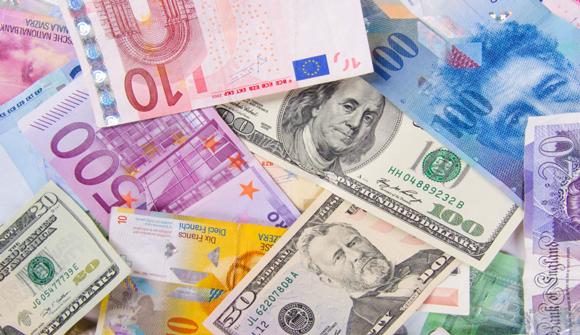
Central Banks Move to Drive Down Currencies, Yielding Domino Effect … The central-bank stimulus spree of 2015 has the look of a global currency war. In quick succession, countries representing about a third of the world's economic output—from the eurozone to China, Australia and Canada—have taken steps that have driven down the value of their currencies. – Wall Street Journal
Dominant Social Theme: We must debase currencies to build them up.
Free-Market Analysis: We've been writing about this race to the bottom for months now. From our point of view, it seems like a kind of directed history.
First, central bankers announce the specter of deflation and then they gradually take steps to combat it. They also announce that the economy itself is in danger of collapsing.
But really, these bailouts probably do two things, mainly: They lessen sovereign and bank debt, and they allow banks eventually to post larger balance sheets.
Many major banks have come to participate in debasement over the past year, or have expanded programs in Europe, China and Japan. Until recently the US was directly involved in an easing program.
But now with Europe easing more aggressively and Japan stepping into another easing program, it seems like debasement has taken hold powerfully around the world.
Here's more:
Half the central banks representing the Group of 20 developed and large emerging economies, whose top monetary and finance officials meet to discuss the global economy this week in Istanbul, have taken easing steps so far this year.
The moves—mainly in the form of interest-rate cuts but also asset purchases—have ricocheted through foreign-exchange markets, driving the currencies of some countries down and those of others, primarily the U.S., up. That helps the economies of countries that are easing while complicating life for some central banks, such as the Federal Reserve, and creating challenges for exporters, from the U.S. to Switzerland and Denmark.
"There is a growing consensus in the market that an unspoken currency war has broken out," David Woo and Vadim Iaralov at Bank of America Merrill Lynch said in a note to clients, noting that the magnitude of currency-market swings this year has hit its highest noncrisis level in 20 years.
The article goes on to rebut the above conclusion. It claims that central banks and governments are not aiming to achieve advantageously debased currency but are simply doing "what they think is best for their economies."
The article even explains that there are positives regarding currency wars, as the debasement contagion often moves a variety of currencies down in value at the same time. Curiously, the article doesn't make that point, preferring to speak of "easy-money campaigns."
The article rehearses the recent history of easing. It began, we are told, with the recent announcement by the European Central Bank that it might buy back bonds in a program of up to US$2 trillion. Follow-up tremors included announcement by Switzerland that it would depeg the franc from the euro, so that the franc wouldn't be debased, too.
Denmark chose another route, cutting interest rates four times to ensure that a cheaper euro would not create a more expensive currency in Denmark. Still to come from a rate-cutting standpoint are Sweden and Poland and even the Czech central bank.
Central bankers have apparently convinced themselves that there is less risk inherent in currency debasement from price inflation. They feel free to print money and push interest rates even below the "zero bound" to create cheap money.
The article closes by pointing out that, "The U.S. is already seeing the negative effects of a stronger dollar, with trade slicing one percentage point from fourth-quarter growth. Still, its economy is cranking out jobs at a rapid pace."
This latter point is debatable, of course. Jim Clifton, the Chairman and CEO of Gallup, made recent headlines when he claimed the percentage of Americans employed full-time still approached record lows, even though the Great Recession began in 2008.
His point was that the economy really has not rebounded but that US citizens are unaware of the static nature of the economy because the numbers are regularly fudged. The official 5.6 percent unemployment rate is a "big lie," Clifton was reported as saying. Citizens working 20 hours or more are between 42 percent and 45 percent of the work force, Gallup says.
The Journal article provides us with a figure of 92.90 million Americans "not in the labor force" – who might work if they could. Of course, many probably are via black or gray markets. But such markets are not nearly so efficient as legal ones
If easing worked, it already would have. Some US$50 trillion has been dumped into markets around the world in the past six years with little to show for it from an economic stimulus standpoint. In fact, what's mainly been accomplished economically is the formation of continued asset bubbles.
It seems there will be more easing and thus more currency debasements helping stock markets and banks. But the consequences of such easing are inevitably negative when the business cycle turns.
This Journal article confirms that central banks around the world are easing and claims that such programs are serendipitous. Our preferred perspective is that they are coordinated by the Bank for International Settlements and that this debasement is part of a larger calculated plan.

As we've pointed out before, it won't end well.
